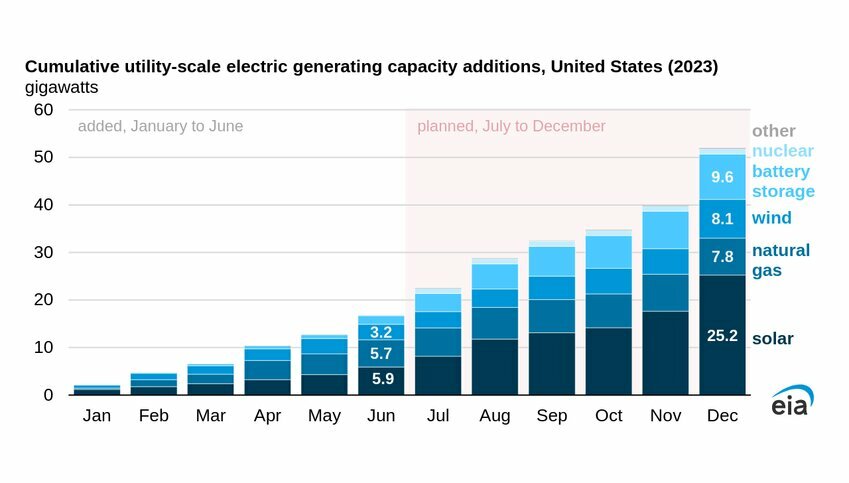 (Credit: EIA)
(Credit: EIA)The Energy Information Administration (EIA) has released a report on the power grid’s growth and usage for the first half of 2023, which shows the U.S. power grid experienced growth as developers added a total of 16.8 gigawatts of new utility-scale electric generating capacity with solar energy providing a significant additional source, according to the latest inventory of electric generators.
As the year progresses, an additional 35.2 GW of capacity is planned to be brought online in the second half, the EIA said.
Solar power emerged as the main contributor to the added capacity, accounting for 35% (5.9 GW) of the total new capacity over the first half of 2023. This, however, fell short by 4.6 GW from the initial projections for the period.
Supply chain challenges were the primary factor behind this discrepancy. Among the states, Florida stood out by contributing 25% of the national total, with Florida Power and Light leading the charge by adding nearly 80% of the solar capacity in the state.
Natural gas, though not as prominent as solar power, came in second, fueling 34% (5.7 GW) of the new capacity. Notably, the two largest projects that commenced operations were natural gas-fired plants – the Guernsey Power Station in Ohio (1.8 GW) and the CPV Three Rivers Energy Center in Illinois (1.2 GW).
Wind energy constituted 19% (3.2 GW) of the total capacity additions, closely followed by battery storage at 11% (1.8 GW). Most of the new battery storage capacity emerged in Texas and California.
A significant highlight was Vistra Energy's expansion of the Moss Landing power station in California, adding 350 MW to make it the largest battery storage facility in the U.S.
Looking ahead, developers have ambitious plans to add 35.2 GW of new capacity in the second half of 2023. Solar takes the lead in planned additions (55% or 19.3 GW), followed by battery storage (7.8 GW) and wind (4.9 GW).
On a separate note, a third reactor at Georgia's Vogtle nuclear power plant recently commenced commercial operation, marking the first new U.S. nuclear reactor to start operation since 2016.
Amid the growth, the landscape is also seeing changes in terms of retirements. Of the planned 15.3 GW of electric generating capacity set to retire in 2023, more than half (8.2 GW) was retired in the first half of the year. The retirements are mainly attributed to coal-fired power plants (64%), followed by natural gas (30%), with expectations of retiring 9.8 GW of coal-fired capacity by the end of the year.